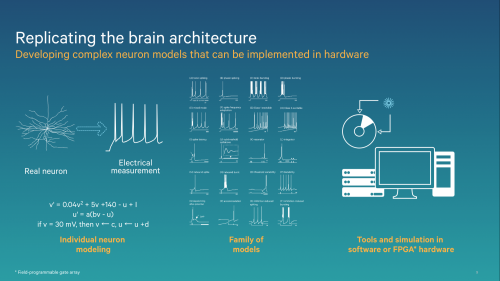(Phys.org) —This month, chipmaker Qualcomm opened up about its progress and goals in work on a brain-inspired chip architecture. The results are impressive. Computers that can mimic the human brain pose a challenge that attracts many computer scientists. While some people take comfort in the difference between computers and humans, such scientists see the difference as a challenge and ask if the gap can be narrowed. Qualcomm, for one, is working away at a computer architecture modeled after the brain, imitating brain processes. In a recent blog posting, Samir Kumar, Qualcomm director business development, presented his overview of the company's Zeroth processors, which are brain–inspired.
"For the past few years our Research and Development teams have been working on a new computer architecture that breaks the traditional mold. We wanted to create a new computer processor that mimics the human brain and nervous system so devices can have embedded cognition driven by brain inspired computing—this is Qualcomm Zeroth processing."
The company envisions "neuro-inspired" chips for robots, vision systems, brain implants and smartphones that will sense and process information more efficiently than ever before. Qualcomm has been focusing on a class of processors called neural processing units (NPUs). designed to be massively parallel, reprogrammable, and capable of cognitive tasks such as classification and prediction
Qualcomm's vision of the smartphone of the future, for example, has NPUs. The handset, like a pet, could be trained, If your phone goes off when it's not supposed to, you could say "bad phone" without having to go into menus and a lot of configurations. The user could teach and train the phone.
Qualcomm already has a suite of software tools that can teach computers good and bad behavior without explicit programming..
Qualcomm CTO Matt Grob recently delivered a sponsored talk at MIT Technology Review's EmTech conference (billed as an event about emerging technologies with the potential to change lives). Grob demonstrated how far Qualcomm has come and where it wants to go with a breakaway architecture.
Grob showed a video of a robot that learns to go to only white tiles on a floor designed with yellow and white tiles. The robot was positively reinforced with "good robot" each time it went to a white tile, and the audience watched as the robot proceeded to only seek out white, not yellow, tiles, without the aid of any unique algorithm or code.
Why is Qualcomm so involved with this work? Grob said that is a question one may ask. "We are wireless; well, mobile is a challenging design environment. We are under constraints for power, performance and size." As it turns out, he said, a brain has a different architecture than computers and is considerably power-efficient.
Qualcomm looks to biology for inspiration to a new generation of processors; he said. "So what do we do? We create a neuron model, then create tools."
Grob said the company is ready to make some of these tools available. According to the MIT Technology Review, the company by next year will be able to partner with researchers and startups, with Qualcomm offering them a platform to realize designs in hardware.
More information: www.qualcomm.com/media/blog/20 … n-inspired-computing
© 2013 Phys.org



















